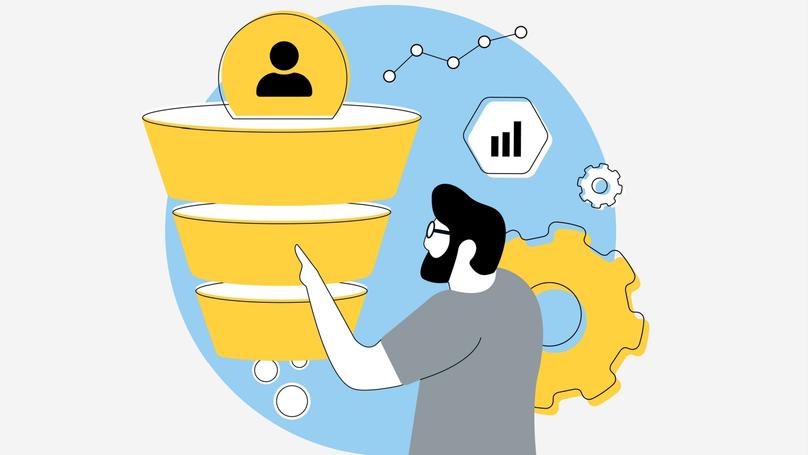Lead qualification

What is a lead qualification?
Lead qualification is the process of evaluating potential buyers to determine their readiness to purchase your product and to encourage this. It involves establishing their particular needs for a product, their authority to make a purchase decision, and their financial ability to afford the product. By analysing these factors, the lead qualification process helps identify which leads are genuinely interested in buying and should be targeted in marketing attempts.
Lead qualification, by definition, measures a client's potential and enables more targeted, specific, and personalised interactions. This process accelerates the buyer's journey through the sales funnel, leading to faster brand familiarisation and engagement. Additionally, lead qualification helps filter out consumers who do not align with your business goals. It also aids companies in understanding:
-
Can your product solve a problem the potential buyer is facing?
-
Where does the customer work? How else can your product benefit them? What are the traits of your target audience? (This information can help you gather various demographic details.)
-
Is this consumer the actual decision-maker for a product, or are they acting as an advisor? In contrast, is the real decision-maker someone else (for example, a child asking questions about the product and a mother making the final decision)?
-
What are the advantages of your product that the customer should focus on? Is there an opportunity for you to add value to your product compared to your competitors' offerings?
The lead qualification stages
You can begin qualifying leads as soon as a consumer takes any action on your website, such as visiting it, asking a question to a chatbot, or filling out a contact form. This initiates the lead qualification funnel, which is distinct from the sales funnel and is constructed separately. It comprises three steps:
Step 1. Registering leads through the chatbot and having them fill out feedback forms in exchange for a lead magnet, such as a free guide or discount, etc.
Step 2. Directly evaluating leads using lead scoring tools (e.g., user assessment) and transferring the most valuable leads to the sales department, which continues to "warm up" these leads and motivate them to buy something.
Step 3. The sales team interacting with the selected leads when it already possesses basic marketing information about the customer, such as demographic data, viewed products, and preferences. This allows for a deeper qualification process. At this stage, the team identifies the customer's problem, level of interest, and budget. It selects suitable product examples and solutions accordingly.
How to qualify leads
What methods does an auditor use to qualify leads? Each company develops its approach, considering the conditions important to them in each particular case. However, the best practices are recognised as BANT and MEDDIC. These methodologies can be used independently in their pure form or as a template for your approach.
BANT Method
In this method, customer qualification is based on four conditions, represented by the acronym BANT:
-
Budget: How much is the consumer willing to spend to solve this problem?
-
Authority: Does the customer make the purchase decision independently? Who benefits from the product, and who truly gains from it?
-
Need: How much does the lead require your product? What problem are you addressing?
-
Timing: How urgent is it for the buyer to make a purchase? When do they plan to do it?
MEDDIC Method
This method, like BANT, is also broken down into stages:
-
Metrics: Evaluate the key indicators of the lead, such as their income, place of residence, and other relevant parameters. These factors are crucial for tailoring the most attractive offer specifically for the customer.
-
Economic buyer: At this stage, identify the decision maker who influences the client's purchase consideration. By understanding who actually makes the decision, you can present the product appropriately. For example, if a man and his daughter are buying a doll, instead of saying, "Look, this doll will fit well into your interior," say, "Your daughter will play with this doll all day long."
-
Decision process: Understand how consumers make decisions and the stages of approval or consideration they go through. For example, they might first list options in a notebook, then consult with a partner or friends, set it aside for a few days to think, read online reviews, etc. It's also crucial to know how long this process takes, which often depends on the cost of your product (generally, the more expensive and significant the purchase, the longer the decision-making process).
-
Decision criteria: Identify the factors the client uses to evaluate your product and make a choice. How do they determine that you and your product are trustworthy? This information will help you highlight the benefits and advantages of your product that matter most to the client in your presentation.
-
Identify the Problem: Understand the client's tasks and challenges. This will enable you to tailor your offer more precisely and build a trusting relationship with the lead.
-
Champion: Engage someone who has successfully used your product to help the lead validate the benefits during the lead "warming" process. This can be done through visual instructions, advertising, storytelling, or by involving a person with a similar problem and experience as a manager or negotiator.
All other lead qualification strategies are similar and typically differ only by including additional or optional stages. They are also applicable to B2B leads.
Categories of leads

Leads vary based on the teams that handle them and their readiness to buy. Consequently, there are three sequential types of leads:
Type 1. Marketing leads (or MQL for short)
This is the initial group of leads collected through lead magnets, which the marketing team is engaging with. Typically, marketing leads consist of subscribers to the company's channels, social networks, and email newsletters. These leads are no longer cold, as they have shown particular interest in your product, but they are still at the beginning of their journey. The marketing team conducts initial qualification and sections these leads into narrower groups based on their actions and level of involvement. Once these leads are sufficiently nurtured, they move to the next group.
Type 2. Sales leads (SAL)
These leads, known as sales leads, are managed by the sales department. They include pre-qualified leads with identified attributes and basic requests. The sales team contacts these leads, selects a suitable product, presents it, addresses objections, schedules meetings, answers questions, and ultimately guides the lead to a deal, transitioning them to the third group.
Type 3. Sales-ready leads (SQL)
These leads are prepared to make a purchase. They are managed by the sales team, specifically by the managers responsible for processing deals or top managers for significant transactions. The sales team further qualifies these leads as needed, ensuring the chosen product accurately meets the customer's needs. Suppose new insights arise, or their issues change significantly, or additional requests become apparent during the conversation. In that case, the sales team adjusts the solution accordingly and completes the sale seamlessly.
Some marketers also differentiate outbound leads, which are leads where the company initiates the first contact rather than the leads themselves. In this scenario, the methods discussed in the previous section can be used to qualify these outbound leads, but only after an initial introduction, similar to cold sales.
Lead disqualification
While the primary goal of lead qualification is to analyse a potential consumer's personal data and guide them towards a sale, it's vital to remember that this data can also be used for disqualification. This is a distinct but related process that helps your team improve its efforts by excluding segments that are clearly unsuitable for your marketing strategy and activities. In other words, these are leads that will not buy anything under any circumstances. Therefore, the process of qualifying leads also enables you to disqualify some of them. This is done by collecting information about the customer and checking it against the criteria.
So, which leads are deemed unsuitable and should, therefore, be disqualified?
-
Leads that show no interest in your company or product. This is evident through complete indifference and lack of engagement when attempts are made to "warm up" the lead. For instance, the consumer may not respond to calls or questions or may explicitly state that they are not interested.
-
The lead is not part of your target audience. The chances of this lead becoming active are too low to justify investing resources. The problem likely points out that you are not relevant to this lead, and therefore, your product does not address their needs.
-
The cost of your goods or services exceeds the lead's budget. It's crucial to consider clients' financial ability during the initial qualification to avoid passing on a lead to the sales department, who cannot afford your product. However, the lead's financial situation may change over time. In such cases, the lead can be placed on a "waiting list" and revisited later.
At the same time, you should not disqualify leads who are not ready to buy, such as those "stuck" in the sales funnel or those who explicitly state this. These leads should either be left where they are or continue to be warmed through informative mailings, discounts, interesting content, etc. This is, of course, provided that the lead continues to visit your group or website and engage with your content. Otherwise, the lead falls into the "uninterested leads" category and is excluded altogether.
Tools and software for lead qualification

There are numerous services and programs for lead qualification, many of which integrate with CRM systems or cloud storage. These are often comprehensive frameworks with a wide range of functions for customer management. For example, we recommend considering the following and familiarising yourself with them:
Drift
An AI-powered automated lead qualification platform studies, understands, and interacts with customers, creating a highly personalised experience and increasing the number of touchpoints. This platform includes AI-driven chatbots that can communicate with users 24/7, analyse their site navigation intentions, determine priorities, and then qualify and pass them on to the sales team. Drift is commonly used for qualifying customers based on website traffic, with pricing starting at $2,500 per month.
HubSpot Marketing Hub
A comprehensive platform for automating all aspects of marketing, including lead generation and processing. This platform offers tools for lead search, email marketing, social media management, and advertising campaign analytics. HubSpot enables you to connect and set up multichannel marketing, providing data for lead qualification and assessing lead compliance with company requirements and profitability. It's also one of the most budget-friendly options, with subscriptions starting at $45 per month.
Exceed.ai
Another AI-based platform for automated lead qualification is Exceed.ai. Its unique feature is the ability to conduct contextual conversations with potential clients across various channels, from email to social media chats. Essentially, purchasing Exceed.ai gives you a fully developed online employee who can schedule meetings, ask clarifying questions, and redirect leads to the appropriate sales or other departments for further qualification. Access to Exceed.ai is available upon request, with prices starting at $1,950 per month.
Lead qualification checklist
We have prepared a checklist for qualifying inbound leads, ensuring you can fully assess them on all factors, warm them up, and pass them on without missing anything! Make sure to answer all these questions about your lead before qualifying them and passing them on for further work:
-
Is the prospect genuinely interested in your product, service, or company?
-
Do they genuinely need your solution?
-
Does this customer have the budget to purchase your solution?
-
Is this customer the independent decision-maker?
-
Is now the right time for this customer to purchase your product?
-
Is the customer taking too long to decide or qualify, possibly due to unforeseen difficulties?
-
Are there any clear, objective reasons to disqualify this lead?
Once you have answered all these questions positively, proceed to the next set of questions to further qualify the lead and increase their readiness to buy:
-
Have you gathered sufficient contact information and other details about the customer, including their interests, problem areas, and demographics?
-
Have you pinpointed the customer's pains, and do you have a solution to resolve them?
-
Do you have a tailored marketing strategy and the necessary tools to present the product uniquely to this customer?
-
How prepared is this customer to purchase something, and can you proceed immediately? If not, what tools can you use to enhance their readiness?
-
Can this consumer grow from a one-time buyer to a regular customer? If so, what strategies and tools can you use to achieve this?
Conclusion
Lead qualification not only helps a business determine if a potential consumer will convert but also increases the likelihood of conversion by guiding the customer from product awareness to purchase. This process includes both research and marketing, as it enhances buyer engagement and advances them, since generation necessitates direct interaction within the sales funnel.
Therefore, lead qualification can be seen as a comprehensive marketing tool, not just an analytical one. However, it's important to remember that the list of criteria and their relevance to customers are relative and subjective. Each company sets its lead qualification criteria and their number. This means you can adapt any lead qualification model, adding stages or questions as needed, answers to which must be positive, to ensure leads are qualified before passing them to the sales department.
























